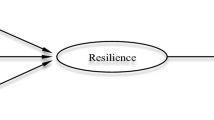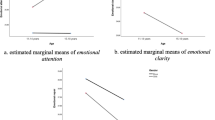Abstract
Emotional intelligence (EI) and dispositional mindfulness are two constructs that have been implicated in well-being, particularly in males, and are often part of student well-being programs. This study examined the relationships between EI, dispositional mindfulness, and well-being in adolescent boys. It was hypothesised that EI would mediate the relationship between dispositional mindfulness and well-being. The sample consisted of 294 adolescent male school students aged 13–17 years (M = 14.13, SD = 1.26). Participants completed self-report questionnaires related to dispositional mindfulness (Mindfulness Attention Awareness Scale for Adolescents), EI (Adolescent Swinburne University Emotional Intelligence Scale), subjective happiness (Subjective Happiness Scale) and psychological distress (General Health Questionnaire). Two multiple mediation models were developed to assess the extent to which EI mediates the relationship between dispositional mindfulness and (1) subjective happiness and (2) psychological distress. The results indicated that three EI dimensions: Emotional Recognition and Expression (ERE), Emotional Management and Control (EMC), and Understanding the Emotions of Others (UEO), were significantly positively correlated with dispositional mindfulness (p < 0.01). In addition, two EI dimensions (ERE and EMC) partially mediated the relationship between dispositional mindfulness and subjective happiness (ERE: PM = 0.22[0.08], 95% CI = 0.09, 0.39; EMC: PM = 0.28[0.11], 95% CI = 0.10, 0.54), and between dispositional mindfulness and psychological distress (ERE: PM = 0.14[0.06], 95% CI = 0.04, 0.26; EMC: PM = 0.31[0.08], 95% CI = 0.17, 0.48). It was concluded that the development of programs incorporating aspects of dispositional mindfulness and EI could provide tangible benefits to the psychological well-being of adolescent males.



Similar content being viewed by others
References
Baer, R. A., Smith, G. T., & Allen, K. B. (2004). Assessment of mindfulness by self-report: the Kentucky Inventory of Mindfulness Skills. Assessment, 11(3), 191–206.
Baer, R. A., Smith, G. T., Hopkins, J., Krietemeyer, J., & Toney, L. (2006). Using self-report assessment methods to explore facets of mindfulness. Assessment, 13(1), 27–45. https://doi.org/10.1177/1073191105283504.
Bao, X., Xue, S., & Kong, F. (2015). Dispositional mindfulness and perceived stress: the role of emotional intelligence. Personality and Individual Differences, 78, 48–52.
Brown, K. W., & Ryan, R. M. (2003). The benefits of being present: mindfulness and its role in psychological well-being. Journal of Personality and Social Psychology, 84(4), 822–848.
Brown, K. W., Kasser, T., Ryan, R. M., Linley, P. A., & Orzech, K. (2009). When what one has is enough: mindfulness, financial desire discrepancy, and subjective well-being. Journal of Research in Personality, 43(5), 727–736. https://doi.org/10.1016/j.jrp.2009.07.002.
Brown, K. W., West, A. M., Loverich, T. M., & Biegel, G. M. (2011). Assessing adolescent mindfulness: validation of an Adapted Mindful Attention Awareness Scale in adolescent normative and psychiatric populations. Psychological Assessment, 23(4), 1023–1033. https://doi.org/10.1037/a0021338.
Campos, D., Cebolla, A., Quero, S., Breton-Lopez, J., Botella, C., Soler, J., et al. (2016). Meditation and happiness: mindfulness and self-compassion may mediate the meditation-happiness relationship. Personality and Individual Differences, 93, 80–85. https://doi.org/10.1016/j.paid.2015.08.040.
Carlson, L., & Brown, K. W. (2005). Validation of the mindful attention awareness scale in a cancer population. Journal of Psychosomatic Research, 58(1), 29–33.
Charbonneau, D., & Nicol, A. A. M. (2002). Emotional intelligence and prosocial behaviors in adolescents. Psychological Reports, 90(2), 361–370. https://doi.org/10.2466/pr0.2002.90.2.361.
Ciarrochi, J., Kashdan, T. B., Leeson, P., Heaven, P., & Jordan, C. (2011). On being aware and accepting: a one-year longitudinal study into adolescent well-being. Journal of Adolescence, 34(4), 695–703.
Ciesla, J. A., Reilly, L. C., Dickson, K. S., Emanuel, A. S., & Updegraff, J. A. (2012). Dispositional mindfulness moderates the effects of stress among adolescents: rumination as a mediator. Journal of Clinical Child & Adolescent Psychology, 41(6), 760–770.
Dekeyser, M., Raes, F., Leijssen, M., Leysen, S., & Dewulf, D. (2008). Mindfulness skills and interpersonal behaviour. Personality and Individual Differences, 44(5), 1235–1245.
Downey, L. A., Johnston, P. J., Hansen, K., Schembri, R., Stough, C., Tuckwell, V., & Schweitzer, I. (2008a). The relationship between emotional intelligence and depression in a clinical sample. European Journal of Psychiatry, 22(2), 93–98.
Downey, L. A., Mountstephen, J., Lloyd, J., Hansen, K., & Stough, C. (2008b). Emotional intelligence and scholastic achievement in Australian adolescents. Australian Journal of Psychology, 60(1), 10–17. https://doi.org/10.1080/00049530701449505.
Downey, L. A., Johnston, P. J., Hansen, K., Birney, J., & Stough, C. (2010). Investigating the mediating effects of emotional intelligence and coping on problem behaviours in adolescents. Australian Journal of Psychology, 62(1), 20–29.
Fergusson, D. M., & Woodward, L. J. (2002). Mental health, educational, and social role outcomes of adolescents with depression. Archives of General Psychiatry, 59(3), 225–231.
French, D. J., & Tait, R. J. (2004). Measurement invariance in the General Health Questionnaire-12 in young Australian adolescents. European Child & Adolescent Psychiatry, 13(1), 1–7. https://doi.org/10.1007/s00787-004-0345-7.
Frewen, P. A., Evans, E. M., Maraj, N., Dozois, D. J. A., & Partridge, K. (2008). Letting go: mindfulness and negative automatic thinking. Cognitive Therapy and Research, 32(6), 758–774. https://doi.org/10.1007/s10608-007-9142-1.
Giluk, T. L. (2009). Mindfulness, Big Five personality, and affect: a meta-analysis. Personality and Individual Differences, 47(8), 805–811.
Goldberg, D. P., & Hillier, V. F. (1979). A scaled version of the general health questionnaire. Psychological Medicine, 9(1), 139–145.
Greco, L. A., Baer, R. A., & Smith, G. T. (2011). Assessing mindfulness in children and adolescents: development and validation of the Child and Adolescent Mindfulness Measure (CAMM). Psychological Assessment, 23(3), 606–614.
Gugliandolo, M. C., Costa, S., Cuzzocrea, F., Larcan, R., & Petrides, K. V. (2015). Trait emotional intelligence and behavioral problems among adolescents: a cross-informant design. Personality and Individual Differences, 74, 16–21. https://doi.org/10.1016/j.paid.2014.09.032.
Hansen, K., Gardner, L., & Stough, C. (2007). Improving occupational stress through emotional intelligence development. Organisations and People, 14(2), 70.
Hayes, A. F. (2013). Introduction to mediation, moderation, and conditional process analysis: a regression-based approach (2nd ed.). New York: The Guilford Press.
Howell, A. J., Digdon, N. L., Buro, K., & Sheptycki, A. R. (2008). Relations among mindfulness, well-being, and sleep. Personality and Individual Differences, 45(8), 773–777. https://doi.org/10.1016/j.paid.2008.08.005.
Huppert, F. A., & Johnson, D. M. (2010). A controlled trial of mindfulness training in schools: the importance of practice for an impact on well-being. The Journal of Positive Psychology, 5(4), 264–274. https://doi.org/10.1080/17439761003794148.
IBM Corp. (2016). IBM SPSS Statistics for Mac (Version 24.0.0.0). Armonk: IBM Corp..
Kong, F., Wang, X., & Zhao, J. J. (2014). Dispositional mindfulness and life satisfaction: the role of core self-evaluations. Personality and Individual Differences, 56, 165–169. https://doi.org/10.1016/j.paid.2013.09.002.
Kuyken, W., Weare, K., Ukoumunne, O. C., Vicary, R., Motton, N., Burnett, R., et al. (2013). Effectiveness of the Mindfulness in Schools Programme: non-randomised controlled feasibility study. The British Journal of Psychiatry, 203(2), 126–131.
Lomas, J., Stough, C., Hansen, K., & Downey, L. A. (2012). Brief report: emotional intelligence, victimisation and bullying in adolescents. Journal of Adolescence, 35(1), 207–211. https://doi.org/10.1016/j.adolescence.2011.03.002.
Luebbers, S., Downey, L. A., & Stough, C. (2007). The development of an adolescent measure of EI. Personality and Individual Differences, 42(6), 999–1009. https://doi.org/10.1016/j.paid.2006.09.009.
Lyubomirsky, S., & Lepper, H. S. (1999). A measure of subjective happiness: preliminary reliability and construct validation. Social Indicators Research, 46(2), 137–155. https://doi.org/10.1023/a:1006824100041.
Marks, A. D. G., Sobanski, D. J., & Hine, D. W. (2010). Do dispositional rumination and/or mindfulness moderate the relationship between life hassles and psychological dysfunction in adolescents? Australian and New Zealand Journal of Psychiatry, 44(9), 831–838.
Mayer, J. D., Salovey, P., & Caruso, D. R. (2000). Emotional intelligence as zeitgeist, as personality, and as a mental ability. In R. Bar-On & J. D. A. Parker (Eds.), The handbook of emotional intelligence (pp. 92–117). New York: Jossey-Bass.
Palmer, B., & Stough, C. (2001). Workplace SUEIT: Swinburne university emotional intelligence test–descriptive report. Swinburne University, AU: Organisational Psychology Research Unit.
Preacher, K. J., & Hayes, A. F. (2008). Asymptotic and resampling strategies for assessing and comparing indirect effects in multiple mediator models. Behavior Research Methods, 40(3), 879–891. https://doi.org/10.3758/BRM.40.3.879.
Raes, F., Dewulf, D., Van Heeringen, C., & Williams, J. M. G. (2009). Mindfulness and reduced cognitive reactivity to sad mood: evidence from a correlational study and a non-randomized waiting list controlled study. Behaviour Research and Therapy, 47(7), 623–627.
Resurreccion, D. M., Salguero, J. M., & Ruiz-Aranda, D. (2014). Emotional intelligence and psychological maladjustment in adolescence: a systematic review. Journal of Adolescence, 37(4), 461–472. https://doi.org/10.1016/j.adolescence.2014.03.012.
Riggs, N. R., Black, D. S., & Ritt-Olson, A. (2015). Associations between dispositional mindfulness and executive function in early adolescence. Journal of Child and Family Studies, 24(9), 2745–2751.
Salovey, P., & Mayer, J. D. (1990). Emotional intelligence. Imagination, Cognition and Personality, 9(3), 185–211.
Sanchez-Alvarez, N., Extremera, N., & Fernandez-Berrocal, P. (2015). Maintaining life satisfaction in adolescence: affective mediators of the influence of perceived emotional intelligence on overall life satisfaction judgments in a two year longitudinal study. Frontiers in Psychology, 6, 1892. https://doi.org/10.3389/fpsyg.2015.01892.
Schutte, N. S., & Malouff, J. M. (2011). Emotional intelligence mediates the relationship between mindfulness and subjective well-being. Personality and Individual Differences, 50(7), 1116–1119.
Smith, J. M. (2004). Adolescent males’ view on the use of mental health counseling services. Adolescence, 39(153), 77–82.
Wang, Y., & Kong, F. (2014). The role of emotional intelligence in the impact of mindfulness on life satisfaction and mental distress. Social Indicators Research, 116(3), 843–852.
Wen, Z., & Fan, X. (2015). Monotonicity of effect sizes: questioning kappa-squared as mediation effect size measure. Psychological Methods, 20(2), 193–203. https://doi.org/10.1037/met0000029.
Xu, W., Rodriguez, M. A., Zhang, Q., & Liu, X. H. (2015). The mediating effect of self-acceptance in the relationship between mindfulness and peace of mind. Mindfulness, 6(4), 797–802. https://doi.org/10.1007/s12671-014-0319-x.
Author information
Authors and Affiliations
Contributions
CT: designed and executed the study, assisted with the data analyses, and drafted the paper. LD: collaborated with the design of the study, analysis of the data, and the drafting and finalising of the paper. TF: conducted the final analyses of the data and collaborated with editing and finalising the paper. JL and CS: collaborated with the design and execution of the study. EB: conducted the initial analysis of the data.
Corresponding author
Ethics declarations
Ethical Approval
All procedures performed in studies involving human participants were in accordance with the ethical standards of the Swinburne University Ethics committee and with the 1964 Helsinki declaration and its later amendments or comparable ethical standards.
Conflict of Interest
The authors declare that they have no conflict of interest.
Informed Consent
Informed consent was obtained from all individual participants and from the parents of each child included in the study.
Rights and permissions
About this article
Cite this article
Teal, C., Downey, L.A., Lomas, J.E. et al. The Role of Dispositional Mindfulness and Emotional Intelligence in Adolescent Males. Mindfulness 10, 159–167 (2019). https://doi.org/10.1007/s12671-018-0962-8
Published:
Issue Date:
DOI: https://doi.org/10.1007/s12671-018-0962-8




